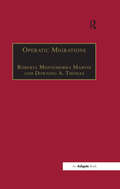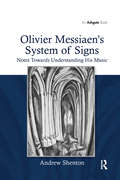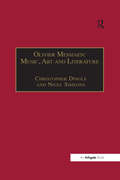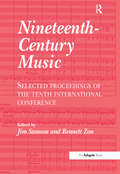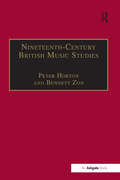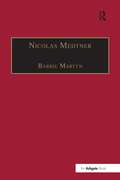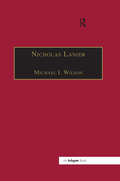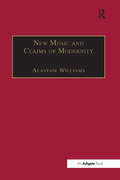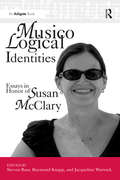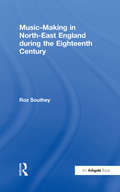- Table View
- List View
Operatic Migrations: Transforming Works and Crossing Boundaries
by DowningA. ThomasThis volume takes an interdisciplinary approach to studying a wide range of subjects associated with the creation, performance and reception of 'opera' in varying social and historical contexts from the eighteenth to the twentieth centuries. Each essay addresses migrations between genres, cultures, literary and musical works, modes of expression, media of presentation and aesthetics. Although the directions the contributions take are diverse, they converge in significant ways, particularly with the rebuttal of the notion of the singular nature of the operatic work. The volume strongly asserts that works are meaningfully transformed by the manifold circumstances of their creation and reception, and that these circumstances have an impact on the life of those works in their many transformations and on a given audience's experience of them. Topics covered include transformations of literary sources and their migration into the operatic genre; works that move across geographical and social boundaries into different cultural contexts; movements between media and/or genre as well as alterations through interpretation and performance of the composer's creation; the translation of spoken theatre to lyric theatre; the theoretical issues contingent on the rendering of 'speech' into 'song'; and the transforming effects of aesthetic considerations as they bear on opera. Crossing over disciplinary boundaries between music, literary studies, history, cultural studies and art history, the volume enriches our knowledge and understanding of the operatic experience and the works. The book will therefore appeal to those working in the field of music, literary and cultural studies, and to those with a particular interest in opera and musical theatre.
Opera Remade, 1700-1750
by Charles DillOpera in the first half of the eighteenth century saw the rise of the memorable composer and the memorable work. Recent research on this period has been especially fruitful, showing renewed interest in how opera operated within its local cultures, what audience members felt was at stake in opera performances, who the people-composers and performers-were who made opera possible. The essays for this volume capture the principal themes of current research: the "idea" of opera, opera criticism, the people of opera, and the emerging technologies of opera.
Opera Remade, 1700-1750
by Charles DillOpera in the first half of the eighteenth century saw the rise of the memorable composer and the memorable work. Recent research on this period has been especially fruitful, showing renewed interest in how opera operated within its local cultures, what audience members felt was at stake in opera performances, who the people-composers and performers-were who made opera possible. The essays for this volume capture the principal themes of current research: the "idea" of opera, opera criticism, the people of opera, and the emerging technologies of opera.
Opera From the Greek: Studies in the Poetics of Appropriation
by Michael EwansMichael Ewans explores how classical Greek tragedy and epic poetry have been appropriated in opera, through eight selected case studies. These range from Monteverdi's Il ritorno d'Ulisse in patria, drawn from Homer's Odyssey, to Mark-Antony Turnage's Greek, based on Sophocles's Oedipus the King. Choices have been based on an understanding that the relationship between each of the operas and their Greek source texts raise significant issues, involving an examination of the process by which the librettist creates a new text for the opera, and the crucial insights into the nature of the drama that are bestowed by the composer's musical setting. Ewans examines the issues through a comparative analysis of significant divergences of plot, character and dramatic strategy between source text, libretto and opera.
Opera From the Greek: Studies in the Poetics of Appropriation
by Michael EwansMichael Ewans explores how classical Greek tragedy and epic poetry have been appropriated in opera, through eight selected case studies. These range from Monteverdi's Il ritorno d'Ulisse in patria, drawn from Homer's Odyssey, to Mark-Antony Turnage's Greek, based on Sophocles's Oedipus the King. Choices have been based on an understanding that the relationship between each of the operas and their Greek source texts raise significant issues, involving an examination of the process by which the librettist creates a new text for the opera, and the crucial insights into the nature of the drama that are bestowed by the composer's musical setting. Ewans examines the issues through a comparative analysis of significant divergences of plot, character and dramatic strategy between source text, libretto and opera.
Opera after 1900
by Margaret NotleyThe articles reprinted in this volume treat operas as opera and from some sort of critical angle; none of the articles uses methodology appropriate for another kind of musical work. Additional criteria used in selecting the articles were that they should not have been reprinted widely before and that taken together they should cover an extended array of significant operas and critical questions about them. Trends in Anglophone scholarship on post-1900 opera then determined the structure of the volume. The anthologized articles are organized according to the place of origin of the opera discussed in each of them; the introduction, however, follows a thematic approach. Themes considered in the introduction include questions of genre and reception; perspectives on librettos and librettists; words, lyricism, and roles of the orchestra; and modernism and other political contexts.
Opera after 1900
by Margaret NotleyThe articles reprinted in this volume treat operas as opera and from some sort of critical angle; none of the articles uses methodology appropriate for another kind of musical work. Additional criteria used in selecting the articles were that they should not have been reprinted widely before and that taken together they should cover an extended array of significant operas and critical questions about them. Trends in Anglophone scholarship on post-1900 opera then determined the structure of the volume. The anthologized articles are organized according to the place of origin of the opera discussed in each of them; the introduction, however, follows a thematic approach. Themes considered in the introduction include questions of genre and reception; perspectives on librettos and librettists; words, lyricism, and roles of the orchestra; and modernism and other political contexts.
Olivier Messiaen's System of Signs: Notes Towards Understanding His Music
by Andrew ShentonAndrew Shenton's groundbreaking cross-disciplinary approach to Messiaen's music presents a systematic and detailed examination of the compositional techniques of one of the most significant musicians of the twentieth century as they relate to his desire to express profound truths about Catholicism. It is widely accepted that music can have mystical and transformative powers, but because 'pure' music has no programme, Messiaen sought to refine his compositions to speak more clearly about the truths of the Catholic faith by developing a sophisticated semiotic system in which aspects of music become direct signs for words and concepts. Using interdisciplinary methodologies drawing on linguistics, cognition studies, theological studies and semiotics, Shenton traces the development of Messiaen's sign system using examples from many of Messiaen's works and concentrating in particular on the M tations sur le myst de la Sainte Trinit or organ, a suite which contains the most sophisticated and developed use of a sign system and represents a profound exegesis of Messiaen's understanding of the Catholic triune God. By working on issues of interpretation, Shenton endeavours to bridge the traditional gap between scholars and performers and to help people listen to Messiaen's music with spirit and understanding.
Olivier Messiaen's System of Signs: Notes Towards Understanding His Music
by Andrew ShentonAndrew Shenton's groundbreaking cross-disciplinary approach to Messiaen's music presents a systematic and detailed examination of the compositional techniques of one of the most significant musicians of the twentieth century as they relate to his desire to express profound truths about Catholicism. It is widely accepted that music can have mystical and transformative powers, but because 'pure' music has no programme, Messiaen sought to refine his compositions to speak more clearly about the truths of the Catholic faith by developing a sophisticated semiotic system in which aspects of music become direct signs for words and concepts. Using interdisciplinary methodologies drawing on linguistics, cognition studies, theological studies and semiotics, Shenton traces the development of Messiaen's sign system using examples from many of Messiaen's works and concentrating in particular on the M tations sur le myst de la Sainte Trinit or organ, a suite which contains the most sophisticated and developed use of a sign system and represents a profound exegesis of Messiaen's understanding of the Catholic triune God. By working on issues of interpretation, Shenton endeavours to bridge the traditional gap between scholars and performers and to help people listen to Messiaen's music with spirit and understanding.
Olivier Messiaen: Music, Art and Literature
by Nigel SimeoneWhen Olivier Messiaen died in 1992, the prevailing image was of a man apart; a deeply religious man whose only sources of inspiration were God and Nature and a composer whose music progressed along an entirely individual path, artistically impervious to contemporaneous events and the whims both of his contemporaries and the critics. Whilst such a view contains a large element of truth, the past ten years has seen an explosion of interest in the composer, and the work of a diverse range of scholars has painted a much richer, more complex picture of Messiaen. This volume presents some of the fruits of this research for the first time, concentrating on three broad, interrelated areas: Messiaen's relationship with fellow artists; key developments in the composer's musical language and technique; and his influences, both sacred and secular. The volume assesses Messiaen's position as a creative artist of the twentieth century in the light of the latest research. In the process, it identifies some of the key myths, confusions and exaggerations surrounding the composer which often mask equally remarkable truths. In attempting to reveal some of those truths, the essays elucidate a little of the mystery surrounding Messiaen as a man, an artist, a believer and a musician. Specifically, the volume covers Messiaen's attitudes and associations to Cocteau, Stravinsky's Les Noces, Dutilleux and Toesca, as well as exploring his teaching techniques, the Trait�e rythme, de couleur et d'ornithologie, Messiaen's harmony, performing and transcription techniques, composing for Ondes Martenot, his association with ballet, Saint Fran‘s d'Assise and the influence of his faith. Messiaen himself contributes directly in the form of a speech that he gave about the tapestry-maker Jean Lur and the collection also includes the first literary translation of L' en bourgeon; the garland of poems written by Messiaen's mother, C�le Sauvage, when she was expecting him. The composer de
Olivier Messiaen: Music, Art and Literature
by Nigel SimeoneWhen Olivier Messiaen died in 1992, the prevailing image was of a man apart; a deeply religious man whose only sources of inspiration were God and Nature and a composer whose music progressed along an entirely individual path, artistically impervious to contemporaneous events and the whims both of his contemporaries and the critics. Whilst such a view contains a large element of truth, the past ten years has seen an explosion of interest in the composer, and the work of a diverse range of scholars has painted a much richer, more complex picture of Messiaen. This volume presents some of the fruits of this research for the first time, concentrating on three broad, interrelated areas: Messiaen's relationship with fellow artists; key developments in the composer's musical language and technique; and his influences, both sacred and secular. The volume assesses Messiaen's position as a creative artist of the twentieth century in the light of the latest research. In the process, it identifies some of the key myths, confusions and exaggerations surrounding the composer which often mask equally remarkable truths. In attempting to reveal some of those truths, the essays elucidate a little of the mystery surrounding Messiaen as a man, an artist, a believer and a musician. Specifically, the volume covers Messiaen's attitudes and associations to Cocteau, Stravinsky's Les Noces, Dutilleux and Toesca, as well as exploring his teaching techniques, the Trait�e rythme, de couleur et d'ornithologie, Messiaen's harmony, performing and transcription techniques, composing for Ondes Martenot, his association with ballet, Saint Fran‘s d'Assise and the influence of his faith. Messiaen himself contributes directly in the form of a speech that he gave about the tapestry-maker Jean Lur and the collection also includes the first literary translation of L' en bourgeon; the garland of poems written by Messiaen's mother, C�le Sauvage, when she was expecting him. The composer de
Nineteenth-Century Music: Selected Proceedings of the Tenth International Conference
by Jim Samson Bennett ZonThis selection of essays represents a wide cross-section of the papers given at the Tenth International Conference on Nineteenth-Century Music held at the University of Bristol in 1998. Sections include thematic groupings of work on musical meaning, Wagner, Liszt, musical culture in France, music and nation, and women and music.
Nineteenth-Century Music: Selected Proceedings of the Tenth International Conference
by Jim SamsonThis selection of essays represents a wide cross-section of the papers given at the Tenth International Conference on Nineteenth-Century Music held at the University of Bristol in 1998. Sections include thematic groupings of work on musical meaning, Wagner, Liszt, musical culture in France, music and nation, and women and music.
Nineteenth-Century British Music Studies: Volume 3
by Peter HortonSelected from papers given at the third biennial conference on Music in Nineteenth-Century Britain, this volume, in common with its two predecessors, reflects the interdisciplinary character of the topic. The introductory essay by Julian Rushton foregrounds some of the questions that are key to this area of study: what is the nineteenth century? what is British music? and did London influence the continent? The essays which follow are divided into broad thematic groups covering aspects of gender, church music, national identity, and local and national institutions. This collection illustrates that while nineteenth-century British music studies is still in its infancy as a field of research, it is one that is burgeoning and contributing to our understanding of British social and cultural life of the period.
Nineteenth-Century British Music Studies: Volume 3
by Peter HortonSelected from papers given at the third biennial conference on Music in Nineteenth-Century Britain, this volume, in common with its two predecessors, reflects the interdisciplinary character of the topic. The introductory essay by Julian Rushton foregrounds some of the questions that are key to this area of study: what is the nineteenth century? what is British music? and did London influence the continent? The essays which follow are divided into broad thematic groups covering aspects of gender, church music, national identity, and local and national institutions. This collection illustrates that while nineteenth-century British music studies is still in its infancy as a field of research, it is one that is burgeoning and contributing to our understanding of British social and cultural life of the period.
Nicolas Medtner: His Life and Music
by Barrie MartynNicholas Medtner (1880-1951) has always been a neglected figure in the history of Russian music, and yet his friend Rachmaninoff considered him the greatest of contemporary composers. He wrote three fine piano concertos, more than one hundred solo piano compositions, including a cycle of fourteen sonatas fully worthy to be set alongside those of Scriabin and Prokofiev, and many beautiful songs. He was also a great pianist. Leaving Russia after the Bolshevik Revolution, Medtner lived for a time in Germany and France before finally settling in London, where he passed the final sixteen years of his life. The present work is the first to tell the full story of his eventful life and to consider in turn each of his compositions. The author has drawn on Medtner‘s own correspondence and writings and collected the reminiscences of those who knew him personally to build a comprehensive picture of a great, if still largely unrecognised, musician.
Nicolas Medtner: His Life and Music
by Barrie MartynNicholas Medtner (1880-1951) has always been a neglected figure in the history of Russian music, and yet his friend Rachmaninoff considered him the greatest of contemporary composers. He wrote three fine piano concertos, more than one hundred solo piano compositions, including a cycle of fourteen sonatas fully worthy to be set alongside those of Scriabin and Prokofiev, and many beautiful songs. He was also a great pianist. Leaving Russia after the Bolshevik Revolution, Medtner lived for a time in Germany and France before finally settling in London, where he passed the final sixteen years of his life. The present work is the first to tell the full story of his eventful life and to consider in turn each of his compositions. The author has drawn on Medtner‘s own correspondence and writings and collected the reminiscences of those who knew him personally to build a comprehensive picture of a great, if still largely unrecognised, musician.
Nicholas Lanier: Master of the King's Musick
by MichaelI. WilsonNicholas Lanier (1588-1666) was not only the first person to hold the office of Master of the Music to King Charles I, he was also a practising painter, a friend of Rubens, Van Dyck and many other artists of his time, and one of the very first great art collectors and connoisseurs. He is especially remembered for the part he played in acquiring, on behalf of Charles I, the famous collection of paintings belonging to the Gonzaga family of Mantua. Many of these paintings still form an important part of the Royal Collection today. In this book the different strands of Lanier's colourful life are for the first time drawn together and presented in a single compelling narrative.
Nicholas Lanier: Master of the King's Musick
by MichaelI. WilsonNicholas Lanier (1588-1666) was not only the first person to hold the office of Master of the Music to King Charles I, he was also a practising painter, a friend of Rubens, Van Dyck and many other artists of his time, and one of the very first great art collectors and connoisseurs. He is especially remembered for the part he played in acquiring, on behalf of Charles I, the famous collection of paintings belonging to the Gonzaga family of Mantua. Many of these paintings still form an important part of the Royal Collection today. In this book the different strands of Lanier's colourful life are for the first time drawn together and presented in a single compelling narrative.
New Music and the Claims of Modernity
by Alastair WilliamsSince 1945 the emphasis in new music has lain in a desire for progress, a concept challenged by postmodernist aesthetics. In this study, Alastair Williams identifies and explores the recurring issues and problems presented by post-war music. Part one examines the German philosopher, Theodor Adorno's portrayal of modernity and his understanding of modernism in music. This is followed by a survey of the developments in music from late Beethoven to Schoenberg, the two composers whose works provided the main anchor points for Adorno's philosophy of music. Parts two and three indicate the ways in which Adorno's aesthetics are pertinent to an understanding of new music. Part two comprises a close examination of the music of Pierre Boulez and John Cage, composers who represent extreme, though related, aspects of contemporary music thought: the primacy of structure versus dissolution. Williams' views the music of Ligeti as an exploration of the interface between these two extremes, personifying Adorno's advocation of an aesthetic which attempts to embrace all its dissimilar parts. In part three the consequences of modernism and the aesthetic approaches of Derrida and de Mann are considered, together with the music of Wolfgang Rihm. Williams concludes with a survey of contemporary music and the postmodernist desire to include a range of compositional references.
New Music and the Claims of Modernity
by Alastair WilliamsSince 1945 the emphasis in new music has lain in a desire for progress, a concept challenged by postmodernist aesthetics. In this study, Alastair Williams identifies and explores the recurring issues and problems presented by post-war music. Part one examines the German philosopher, Theodor Adorno's portrayal of modernity and his understanding of modernism in music. This is followed by a survey of the developments in music from late Beethoven to Schoenberg, the two composers whose works provided the main anchor points for Adorno's philosophy of music. Parts two and three indicate the ways in which Adorno's aesthetics are pertinent to an understanding of new music. Part two comprises a close examination of the music of Pierre Boulez and John Cage, composers who represent extreme, though related, aspects of contemporary music thought: the primacy of structure versus dissolution. Williams' views the music of Ligeti as an exploration of the interface between these two extremes, personifying Adorno's advocation of an aesthetic which attempts to embrace all its dissimilar parts. In part three the consequences of modernism and the aesthetic approaches of Derrida and de Mann are considered, together with the music of Wolfgang Rihm. Williams concludes with a survey of contemporary music and the postmodernist desire to include a range of compositional references.
Musicological Identities: Essays in Honor of Susan McClary
by Jacqueline WarwickNo music scholar has made as profound an impact on contemporary thought as Susan McClary, a central figure in what has been termed the 'new musicology'. In this volume seventeen distinguished scholars pay tribute to her work, with essays addressing three approaches to music that have characterized her own writings: reassessing music's role in identity formation, particularly regarding gender, sexuality, and race; exploring music's capacity to define and regulate perceptions and experiences of time; and advancing new modes of analysis more appropriate to those aspects and modes of musicking ignored by traditional methods. Contributors include, in overlapping categories, many fellow pioneers, current colleagues, and former students, and their essays, like McClary's own work, address a wide range of repertories ranging from the established canon to a variety of popular genres. The collection represents the generational arrival of the 'new' musicology into full maturity, dividing fairly evenly between pre-eminent scholars of music and a group of younger scholars who have already made their mark in significant ways. But the collection is also, and fundamentally, interdisciplinary in nature, in active conversation with such fields as history, anthropology, philosophy, aesthetics, media studies, film music studies, dramatic criticism, women's studies, and cultural studies.
Musicological Identities: Essays in Honor of Susan McClary
by Jacqueline WarwickNo music scholar has made as profound an impact on contemporary thought as Susan McClary, a central figure in what has been termed the 'new musicology'. In this volume seventeen distinguished scholars pay tribute to her work, with essays addressing three approaches to music that have characterized her own writings: reassessing music's role in identity formation, particularly regarding gender, sexuality, and race; exploring music's capacity to define and regulate perceptions and experiences of time; and advancing new modes of analysis more appropriate to those aspects and modes of musicking ignored by traditional methods. Contributors include, in overlapping categories, many fellow pioneers, current colleagues, and former students, and their essays, like McClary's own work, address a wide range of repertories ranging from the established canon to a variety of popular genres. The collection represents the generational arrival of the 'new' musicology into full maturity, dividing fairly evenly between pre-eminent scholars of music and a group of younger scholars who have already made their mark in significant ways. But the collection is also, and fundamentally, interdisciplinary in nature, in active conversation with such fields as history, anthropology, philosophy, aesthetics, media studies, film music studies, dramatic criticism, women's studies, and cultural studies.
Music-Making in North-East England during the Eighteenth Century
by Roz SoutheyThe north-east of England in the eighteenth century was a region where many different kinds of musical activity thrived and where a wide range of documentation survives. Such activities included concert-giving, teaching, tuning and composition, as well as music in the theatre and in church. Dr Roz Southey examines the impulses behind such activities and the meanings that local people found inherent in them. It is evident that music could be perceived or utilized for extremely diverse purposes; as entertainment, as a learned art, as an aid to piety, as a profession, a social facilitator and a support to patriotism and nationalism. Musical societies were established throughout the century, and Southey illustrates the social make-up of the members, as well as the role of Gentlemen Amateurs in the organizing of concerts, and the connections with London and other centres. The book draws upon a rich selection of source material, including local newspapers, council and ecclesiastical records, private papers and diaries and accounts of local tradesman, as well as surviving examples of music composed in the area by Charles Avison, Thomas Ebdon and John Garth of Durham, amongst many others. Charles Avison's importance is focused upon particularly, and his Essay on Musical Expression is considered alongside other contemporary writings of lesser fame. Southey provides a fascinating insight into the type and social class of audiences and their influence on the repertoire performed. The book moves from a consideration of music being used as a 'fashion item', evidenced by the patronage of 'big name' soloists from London and abroad, to fiddlers, ballad singers, music at weddings, funerals, public celebrations, and music for marking the events of the American War of Independence and the French Revolutionary Wars. It can be seen, therefore, that the north east was an area of important musical activity, and that the music was always interwoven into the political, economic, religious and commercial fabric of eighteenth-century life.
Music-Making in North-East England during the Eighteenth Century
by Roz SoutheyThe north-east of England in the eighteenth century was a region where many different kinds of musical activity thrived and where a wide range of documentation survives. Such activities included concert-giving, teaching, tuning and composition, as well as music in the theatre and in church. Dr Roz Southey examines the impulses behind such activities and the meanings that local people found inherent in them. It is evident that music could be perceived or utilized for extremely diverse purposes; as entertainment, as a learned art, as an aid to piety, as a profession, a social facilitator and a support to patriotism and nationalism. Musical societies were established throughout the century, and Southey illustrates the social make-up of the members, as well as the role of Gentlemen Amateurs in the organizing of concerts, and the connections with London and other centres. The book draws upon a rich selection of source material, including local newspapers, council and ecclesiastical records, private papers and diaries and accounts of local tradesman, as well as surviving examples of music composed in the area by Charles Avison, Thomas Ebdon and John Garth of Durham, amongst many others. Charles Avison's importance is focused upon particularly, and his Essay on Musical Expression is considered alongside other contemporary writings of lesser fame. Southey provides a fascinating insight into the type and social class of audiences and their influence on the repertoire performed. The book moves from a consideration of music being used as a 'fashion item', evidenced by the patronage of 'big name' soloists from London and abroad, to fiddlers, ballad singers, music at weddings, funerals, public celebrations, and music for marking the events of the American War of Independence and the French Revolutionary Wars. It can be seen, therefore, that the north east was an area of important musical activity, and that the music was always interwoven into the political, economic, religious and commercial fabric of eighteenth-century life.
